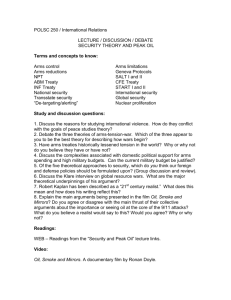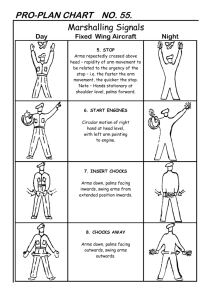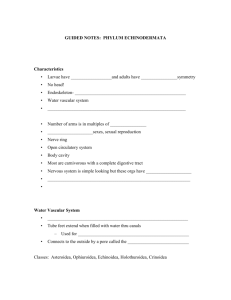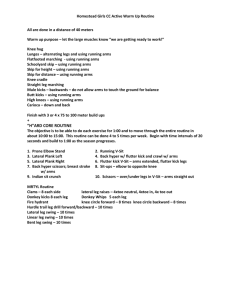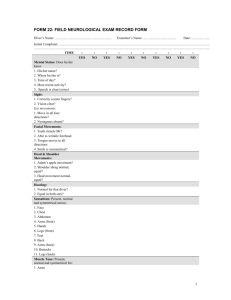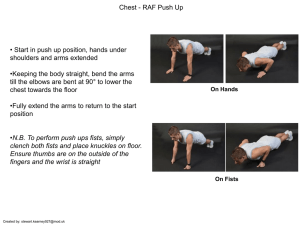Co-curricular physical activities
advertisement
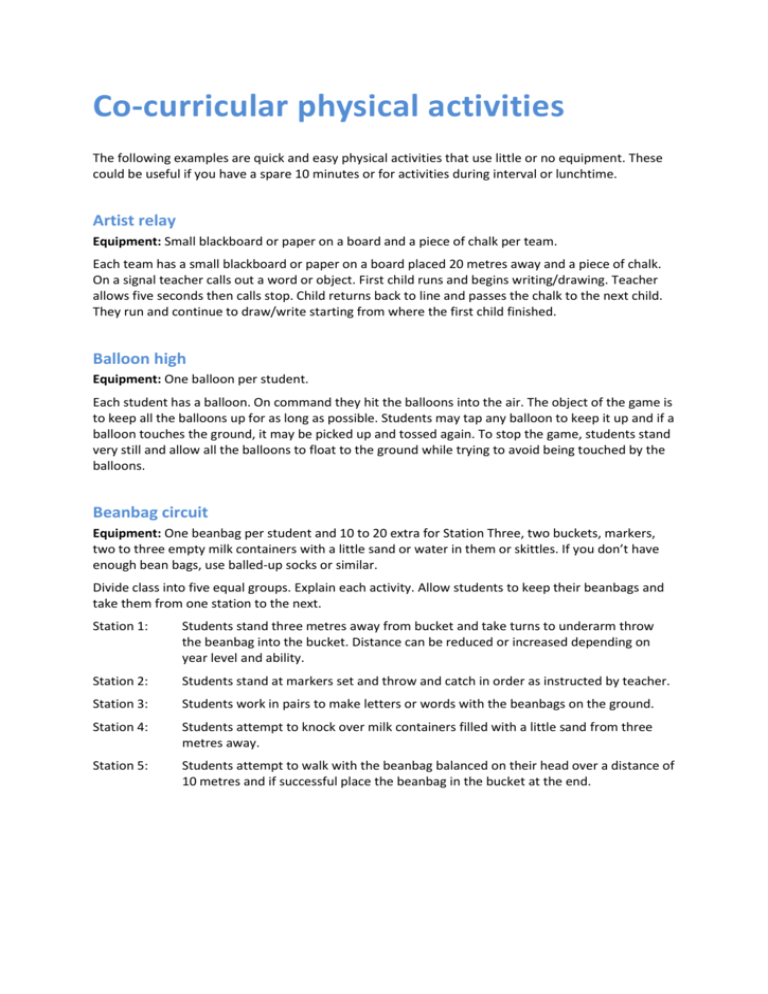
Co-curricular physical activities The following examples are quick and easy physical activities that use little or no equipment. These could be useful if you have a spare 10 minutes or for activities during interval or lunchtime. Artist relay Equipment: Small blackboard or paper on a board and a piece of chalk per team. Each team has a small blackboard or paper on a board placed 20 metres away and a piece of chalk. On a signal teacher calls out a word or object. First child runs and begins writing/drawing. Teacher allows five seconds then calls stop. Child returns back to line and passes the chalk to the next child. They run and continue to draw/write starting from where the first child finished. Balloon high Equipment: One balloon per student. Each student has a balloon. On command they hit the balloons into the air. The object of the game is to keep all the balloons up for as long as possible. Students may tap any balloon to keep it up and if a balloon touches the ground, it may be picked up and tossed again. To stop the game, students stand very still and allow all the balloons to float to the ground while trying to avoid being touched by the balloons. Beanbag circuit Equipment: One beanbag per student and 10 to 20 extra for Station Three, two buckets, markers, two to three empty milk containers with a little sand or water in them or skittles. If you don’t have enough bean bags, use balled-up socks or similar. Divide class into five equal groups. Explain each activity. Allow students to keep their beanbags and take them from one station to the next. Station 1: Students stand three metres away from bucket and take turns to underarm throw the beanbag into the bucket. Distance can be reduced or increased depending on year level and ability. Station 2: Students stand at markers set and throw and catch in order as instructed by teacher. Station 3: Students work in pairs to make letters or words with the beanbags on the ground. Station 4: Students attempt to knock over milk containers filled with a little sand from three metres away. Station 5: Students attempt to walk with the beanbag balanced on their head over a distance of 10 metres and if successful place the beanbag in the bucket at the end. Body co-ordination Equipment: None. Students lie on their backs, feet out and arms by their sides (not too close) and follow directions: Raise their right arm and left leg. Raise their left arm and right leg. Raise two arms. Raise two legs. Pat forehead with right hand and rub tummy with the left hand and vice versa. Make a circle in the air with the left leg. Chair aerobics Equipment: Music and chairs. Everyone sits in their chairs. One person starts the aerobics by making up an action. Everyone else copies the action. Working around the room the next person changes the action and everyone copies. Use music with a good beat to encourage creative ideas and enthusiasm. Practise sequences as a class. See if everyone can move in time to the music. Students could work in groups of four to six and come up with their own chair aerobics sequences to music. They could share this with whānau, others in school or could go on a class visit to a local retirement village and work with the elderly. Types of actions might include: Arms Punching left/right/both arms above the head, straight in front, down to the ground (making hand into a strong fist). Punching alternate arms across the body (twist waist at the same time). Making circles with arms – forwards, backwards, slow, fast (fingers stretched). Arms on shoulders making circles, up and down, in and out so elbows touch. Holding arms out in front with straight arms, flexing fingers in and out. Arms on hips, twisting in chair. Clapping arms above head – keep arms straight. Clapping hands together and then on knees (make patterns). Legs Heel, toe taps – left, right both at same time. Knee lift – left, right, both at same time. Bend and straighten left/right/both legs. Start with knees together and swing legs out to the side. Seated jogging lift with your knees. Pretend to walk with feet off the ground. Lifting leg to cross opposite knee. Legs and arms Punching arms in the air and jogging knees at the same time. Arms straight – opposite arm/knee touches (great for the brain). Jogging moving arms and legs (fast/slow). Opposite arms/legs – bend and straighten, both at same time. Behind chair Get out of your chair and move around it! Swap chairs. Stand behind it and bob up and down. Straight side leg, back leg lifts. Knee lifts – See if you can lift your knee right up to the back of your chair. Lift opposite arm and leg to the side. Up onto your toes with arms up. Reach behind/in front, left arm, right arm, both. Arms on shoulders making circles. Crocodile, snakes and scorpions Equipment: 10 to 15 hoops. Spread hoops on the ground (depending on the size of the group). Students move freely in the set area listening for instructions from the teacher or game leader. When they call out: Crocodiles! Students get inside a hoop (there can be more hoops than students) Snakes! Students stop very still Scorpions! Students jump and shake the scorpions from their bodies Go! Students continue moving freely in the set area. The aim of the game is to save everyone from the crocodiles by moving quickly into a hoop when ‘crocodiles’ is called and helping others to do the same. As the game continues, hoops are removed gradually making it more difficult for students to reach safety from the crocodiles. Variation Different ways of moving can be used e.g. crawling, galloping, side-stepping etc. Possible questions How can we help others to save them from the ‘crocodiles’? What are some encouraging words we can use? How does it feel when everyone is safe from the ‘crocodiles’? Teacher’s note: Remember to use an inclusive method of choosing taggers, game leaders or groups. (Adapted from Active Australia Schools Network.) Dragon Equipment: None. In groups of five to six, students get in a line with their hands on the waist of the person in front of them. The first person in the line (the head) has to try and touch the back person (the tail) while everyone keeps their hands on the person’s waist in front of them. The people in the middle try to keep the head from touching the tail. At the end the tail becomes the head. Elbow tag Equipment: None. Split the students into three groups. One group is the taggers. The other two groups pair up by linking arms. They put their ‘free’ hand on their hip with their elbow bent. The taggers have their hands on their hips and try to tag the pairs using their elbows. If they do, they latch on and the person on the other side of the pair (whose elbow wasn’t tagged) becomes a tagger. Bumper car variation Played in the same way as elbow tag, but the pairs are linked with one person in front of the other. The person at the back has their hands on the waist of the person in front. The taggers tag the back of the pair by putting their hands on their waist and the person in the front becomes a tagger. Freeze tag Equipment: None. When a tagger tags someone they say freeze. The person they tag stands still. Others, who are not tagged, aim to free those who are frozen by touching them twice and saying ‘unfreeze.’ Once unfrozen, the student may unfreeze others also. The taggers aim to freeze everyone. The difficulty of the game depends on the number of taggers. There should be about two to three if a whole class is playing. Funky basketball steps Equipment: Music and a basketball for each pair or student. The Dude Walk Students practise dribbling their basketball to the music using their coolest walk. Remind students to practise using non-preferred hand and to watch where they are going. It’s Just Dribble Students practise dribbling up around a partner and back, then chest pass the ball - partners repeat the movement – all in time with the music. Slam Dunks Students jog around a designated area, dribbling to the music. When the music stops (or on a designated signal) students set up a slam dunk or set shot. High Fives Students jog around in a designated area, dribbling. When the music stops or on a signal, they find the closest person, stand side on and facing the opposite direction to each other and do a vertical jump and give their partner a high five. Human letters Equipment: Ropes. Form larger groups and when the teacher calls out a simple word, students co-operate to form the word with their bodies. Co-operation is important here. Usually students work on a low level such as lying on the ground. Challenge older students to support one another and work on other levels. By using ropes between students to join sides, they can form three-dimensional shapes. This is a good activity to photograph to increase students’ motivation and creativity. It can also be done with numbers and shapes. Jump the stream Equipment: Two ropes. Lay two ropes to create an imaginary stream of water. The stream should be narrow at one end increasing the width gradually towards the other end. Students start at the narrow end of the stream jumping across the stream (two foot take off, two foot landing) working their way to the wider end. Knots Equipment: None. A pair of students turns their back on the group or closes their eyes (the ‘untanglers’). Everyone else stands in a circle holding hands. Without letting go they twist about and step over and under arms to make a big knot. The ‘untanglers’ are asked to open their eyes and untangle the others or to direct the others to untangle themselves. (From the National Heart Foundation’s Jump Rope for Heart resource kit.) Tips Take a look at the Heart Foundation’s Jump for Heart resource kit available at: www.heartfoundation.org.nz. One big circle - Active exercise to music Equipment: Music. Around the room, then in and out. Walk around the room – stop and face into centre. Walk in towards the centre of circle (four or eight counts), on the spot (four or eight counts), walk out again (four or eight counts), on the spot again (four or eight counts). Repeat several times. Around the room, then on the spot. Add different activities as you walk around and stop on the spot. Walk eight counts around the room then eight counts on the spot or 16 around, then 16 on the spot. Walk around the room then on the spot. Do this several times. Then add another activity such as heel digs. Repeat these three activities several times. Then add another activity such as taps to the side. The order would be: walk around room, stop and march on the spot, heel digs, then side taps etc. This ‘add on’ theme can be done facing into the centre of the circle: march into centre, march on the spot, march out, march on the spot. Next step: march into centre, march on the spot, add heel digs, then march backwards to outside, march on the spot, heel digs etc. (From Stephanie McLennan, Sport Waikato.) One, two, three blast off Equipment: None. The number of taggers depends on the size of the class - allow three if the whole class is playing. Taggers count to three while the others run off. Taggers try to tag the others. Students who are tagged turn into a rocket and stand with their arms together straight above their head (like a rocket). In pairs others try to send the rocket off by holding hands around the rocket and saying ‘one, two, three blast off!’ The person who is the rocket is then free to fly away and help send other rockets to fly until tagged again. Traffic lights Equipment: Markers. Designate area. When teacher or student leader calls ‘green’, students move freely in area. On ‘orange’, students hop, skip, and jog on the spot. On ‘red’ students stop and perform a balance until lights change. Ideas for starters Here are some other ideas to start with – not all of them are appropriate for school. They are meant to inspire you and your students. This table could be used to start a class brainstorm on things students can do that involve physical activity. Archery Frescoball Obstacle course Snowboarding Aquafitness Frisbee Octopus Snow sculptures Backyard games Four square Orienteering Spotlight Badminton Games on court markings Patter tennis Squirt hose Bat balloons Gardening Petanque Stretching Ball games Go home stay home Pitching tents Surfing Ball tag Go-karting Playing Swimming Ballet Golf Playing drums Swing ball Bike tricks Gutter ball Playing with whānau Table tennis Body boarding Gymnastics Poi Tag Bowls Haka Practise what you learnt in Physical Education Target throwing Break dancing Handball Rākau sticks Tenpin bowling Building Hang out washing Raking the leaves Theatre sports Building huts Hide and seek Referee a game Three legged run Camping Hiding in long grass Relays Throwing balls Candlestick Hockey Ring-a-ring-a-rosy Throwing sticks Canoeing Hop scotch Rollerblading Touch rugby Capture the flag Hopper jumping Rolling down hills Tramping Carrying firewood Horse riding Rope climbing Trampoline Carrying groceries Jogging Rugby tackling Treasure hunt Charades Jumping waves Running Tubing Clap rhymes/dance Judo Running through sprinkler Tug of war Cleaning the car Kapa haka Sack races Twister Cleaning your bike Kilikiti Sand/snow angels Underwater hockey Cleaning your room Kite flying Sand sculptures Use the stairs Climbing trees Knuckle bones Sāsā Vacuuming Climbing Koosh ball scavenger hunt Volleyball Coach a team Leapfrog Scooter Walking Cooking Line dancing Seesaws Walking the dog Cricket Long jump Shopping Washing Croquet Making beds Skateboard jumps Water festival Cycling Making dams Skiing Water games – washing machines Dancing Making go karts Skip double-dutch Water slides Digging sand Make a raft Skipping Waterskiing Disco Make up a new game Skittles What’s the time Mr Wolf? Doing dishes Midnight Snorkelling Table tennis Elastics Mimes Pitching tents Wheels day Fitness circuit Mountain biking Playing Wheelbarrow races Flying fox Mow lawns Playing drums Yoga

